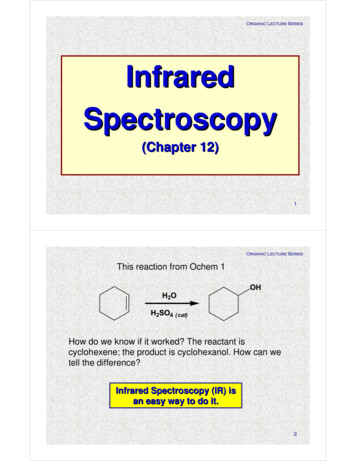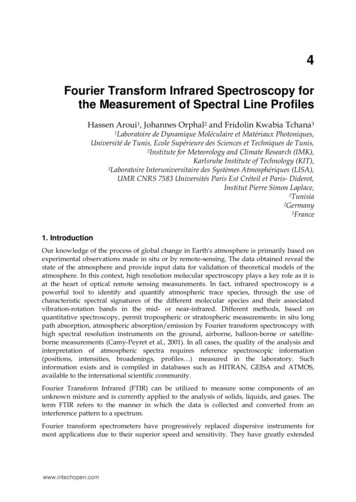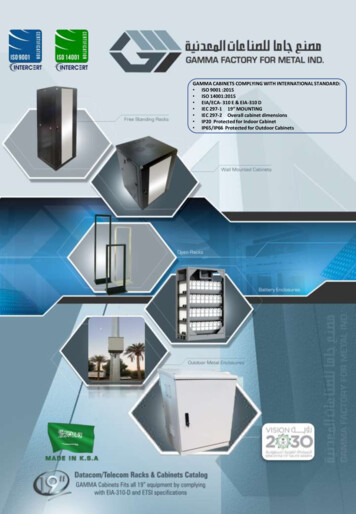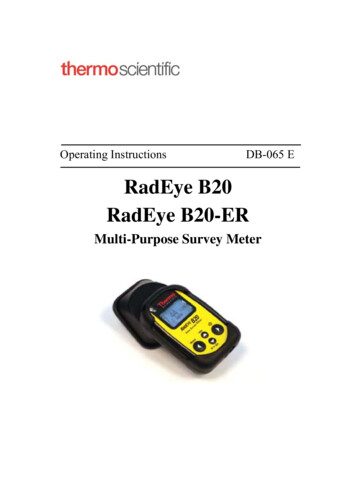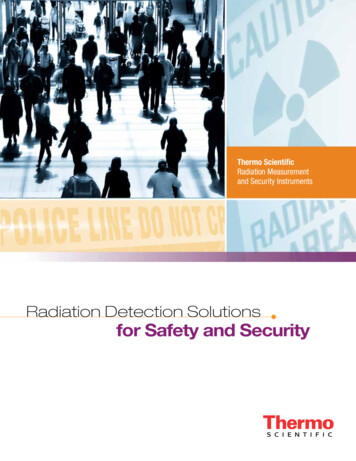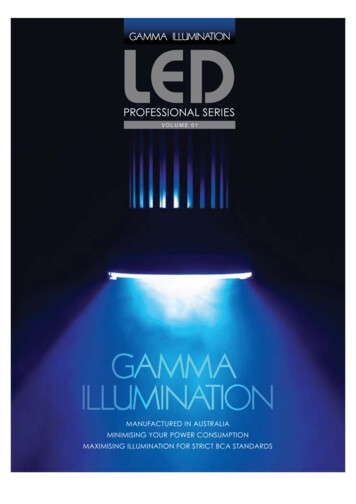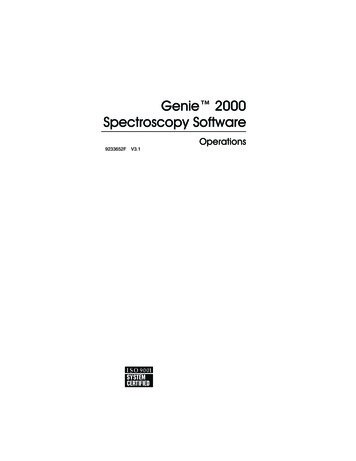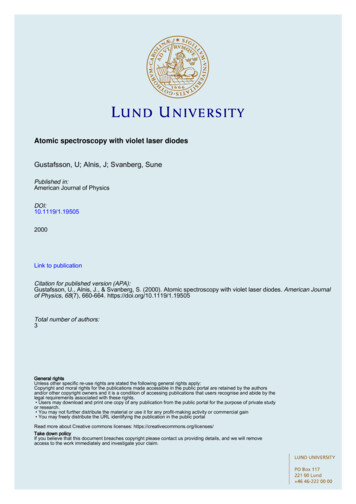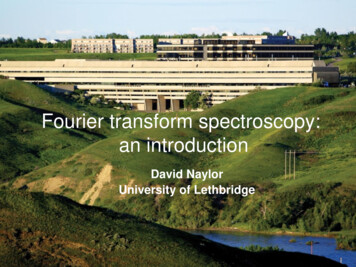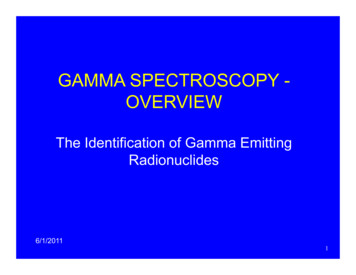
Transcription
GAMMA SPECTROSCOPY OVERVIEWTh IdTheIdentificationifi i off GGamma EmittingE i iRadionuclides6/1/20111
ContentsGeneralDirect gamma Spec Analysis of RadionuclidesNon-Gamma Emitting RadionuclidesNon-Gamma Emitting Radionuclides – Secular EquilibriumNon-Gamma Emitting Radionuclides – Scaling FactorSpectroscopy vs. SpectrometryAdvantages of Gamma SpecDisadvantagesg of Gamma SpecpComponents of a Gamma Spectroscopy SystemThe Most Basic ComponentsDetector TypesTwo “Functions” of the DetectorMultichannel AnalyzerTwo “Functions” of the MCAMajor Components of the MCAAmplifierAnalog to Digital Convertor2
ContentsPulse Height AnalysisGeneralThe SpectrumGeneralThe Big PictureReal SpectraResolutionEnergy CalibrationGeneralPeak CentroidEnergy Calibration CurveIdentifying Unknown Gamma Emitting NuclidesGeneralGamma LibraryUse of ComputerCommon Problems3
ContentsAppendixDead TimeGain ShiftsUpper and Lower level DiscriminatorsSingle Channel Analyzer4
General5
GeneralDirect Gamma Spec Analysis of Radionuclides Radionuclides must emit gamma rays to be analyzeddirectly by gamma spectroscopy Gamma rays are like fingerprints: they have specificenergiesgthat can be used to identifyy the radioactivematerial. The next two slides show a somewhat random selectionof common gamma emitting radionuclides. Many of these nuclides emit gamma rays at manydifferent energies. Only the most important gamma raysare shown.6
GeneralDirect Gamma Spec Analysis of RadionuclidesRadionuclideGamma Ray Energy (keV)Gamma Intensity1274.51.0511.0 (annihilation)1.8K-401460.80.11Cr-51320.10.098C 57Co-57122 1122.10 60Zn-65Ga-67Mo-997
GeneralDirect Gamma Spec Analysis of RadionuclidesRadionuclideGamma Ray Energy (keV)Gamma IntensityTc-99m140.50.89Cd-109 .70.976795.80.854Cs-137 5Am-2418
GeneralNon-Gamma Emitting Radionuclides Radionuclides that do not emit gamma rays, or do so in avery small percentage of their decays (e.g., H-3, C-14, P32, Sr-90, Pu-239) cannot be identified or quantifieddirectly by gamma spectroscopy.In most casescases, they must be analyzed by some othermeans, e.g., radiochemistry. However, if a ratio can be established between a gammaemitting nuclide and a non-gamma emitter, the latter canbe analyzed indirectly by gamma spec.9
GeneralNon-Gamma Emitting Radionuclides – Secular Equilibrium If a non-gamma emitter and a gamma emitting radionuclideare in secular equilibrium, their activities are equal (1:1ratio). Secular equilibrium involves a long-lived parent (usuallythe nonnon-gammagamma emitter) and a short-livedshort lived decay product(usually the gamma emitter). There can be several reasons why secular equilibriummight not exist, hence everyone involved in the analysismust agree with the assumption that the gamma emitterand non-gamma emitter are in equilibrium.10
GeneralNon-Gamma Emitting Radionuclides – Secular EquilibriumExample 1.U-238, which does not emit gamma rays, can bequantified by measuring the activity of one of its shortlived gamma emitting decay products: Th-234 or Pa234m234m.U-238 (4.5 x 109 a) Th-234 (24 d) Pa-234m (1 min)Th-234 emits 63 keV gammas in 3.7% of its decays.Pa-234m emits 1001 keV gammas in 0.84% of its decays.11
GeneralNon-Gamma Emitting Radionuclides – Secular EquilibriumExample 2.Th-232, which does not emit gamma rays, can bequantified by measuring the activity of its short-livedgamma emitting decay product Ac-228.Th-232 (1.4 x 1010 a) Ra-228 (5.75 a) Ac-228 (6.1 h)Ac-228 emits a 911 keV gamma in 28% of its decays.The long time required for Ac-228 to grow into secularequilibrium from purified thorium-232 makes theassumption of equilibrium a little problematic.12
GeneralNon-Gamma Emitting Radionuclides – Secular EquilibriumExample 3.Ra-226, which emits a 186 keV gamma that is impossibleto distinguish from the 186 keV gamma ray of U-235, canbe quantified by measuring the activity of its short-livedgamma emittinggg decayypproduct Pb-214.Ra-226 (1600 a) Rn-222 (3.8 d) Po-218 (3 min) Pb-214 (27 min)Pb-214 emits a 352 keV gamma in 37% of its decays.Equilibrium is reached very quickly (ca. 1 month). Apotential concern is the possible escape of the Rn-222from the sample matrix.13
GeneralNon-Gamma Emitting Radionuclides – Scaling Factor There are times when it is acceptable to make a lessaccurate determination of the non-gamma emitter activity,e.g., assaying low level waste.In this case, considerable uncertainty might be toleratedin the ratio (aka scaling factor) between the non-gammaemitter and the gamma emitter.The ratio just has to be “good enough.” For example, the ratio might be derived from the knownactivities of the two nuclides that were used in a givenprocess or facility.14
GeneralNon-Gamma Emitting Radionuclides – Scaling Factor If the gamma emitter and non-gamma emitter areproduced by the same process, it might be reasonable toassume ratio between them.For example:Radionuclides produced by fission such as the gammaemitter Cs-137 and Sr-90.Radionuclides produced by neutron activation such asthe gamma emitter Co-60 and Fe-55. A somewhat different example: There is often a usableratio between the gamma emitter Am-241 and Pu-239.Am-241 is a decay product of Pu-241 which is oftenpresent along with Pu-239.15
GeneralSpectroscopy vs. Spectrometry A distinction is not always made between these two terms. Often the term gamma spec is used to cover both. When a distinction is made:Gamma spectroscopy refers to the process of using theenergies of gamma rays to identify radionuclidesGamma Spectrometry refers to the process of using thenumber of emitted gamma rays to quantify the activity ofthe radionuclides.16
GeneralAdvantages of Gamma Spec (vs. radiochemistry) Less expensive when compared to radiochemistry Fast Multinuclide analysis. All the gamma emitters can beanalyzed at once.A radiochemical analysis will be for one element only (e.g.,U-234, U-235 and U-238) Non-destructive In some cases can be performed at a distance (remotely)in the field without the need for a sample.17
GeneralDisadvantages of Gamma Spec (vs. radiochemistry) Often less sensitive than radiochemistry, i.e., the MDCs forradiochemical analyses are usually lower than for gammaspectroscopy Usually requires larger sample masses than radiochemistry18
Components of aGamma Spectroscopy System19
Components of a Gamma Spectroscopy SystemThe Most Basic Components1. Detector (and high voltage power supply)2. Multichannel analyzer (MCA)DetectorMultichannelAnalyzer(MCA)High VoltagePower Supply20
Components of a Gamma Spectroscopy SystemDetector Types The most common (not the only) detectors in gammaspectroscopy systems:- Sodium Iodide (NaI)- Lanthanum Bromide (LaBr)- High Purity Germanium (HPGe) Of these, the HPGe is easily the best. A LaBr detector is generally preferable to a NaI detector.21
Components of a Gamma Spectroscopy SystemTwo “Functions” of the Detector1. A pulse is produced for each gamma ray interacting in thedetector.A pulse is a short-term change in the voltage.2. The greater the energy deposited in the detector, thelarger the pulse.22
Components of a Gamma Spectroscopy SystemTwo “Functions” of the DetectorHow many pulses wouldthe detector produce?Source320 keV1173 keV662 keVDetectorHow many different pulse1332 keV sizes would the detectorproduce (assume eachgamma ray energydeposits all its energy inthe detector) ?23
Components of a Gamma Spectroscopy SystemTwo “Functions” of the DetectorSourceSeven pulses of four different sizes.MCAHPGeDetectorLiquidNitrogenDewarPulses24
Components of a Gamma Spectroscopy SystemMultichannel Analyzer The MCA contains most of the system’s electronics. All of the MCA components (and possibly the detector aswell) might be housed in a single stand-alone unit. In somecases, this might be a portable hand-held device. In the laboratory, the memory, display and analysisfunctions of the MCA are usually handled by a computer.The rest of the MCA’s electronic components might behoused in a single “box” connected to the computer.In other cases, the MCA electronics might consist ofseveral modules arranged in a NIM bin.25
Components of a Gamma Spectroscopy SystemMultichannel AnalyzerStand-alone MCA(old system)MCA’s hardware oncomputer circuit board(old system design)26
Components of a Gamma Spectroscopy SystemMultichannel AnalyzerCommon laboratorysetup.HPGe DetectorMCA electronicsconsists of modulesin external NIM Bin.Computer stores,displays andanalyzes thespectra.NIM Bin with Modules27
Components of a Gamma Spectroscopy SystemMultichannel AnalyzerIn-situ gamma spec.Identifying and quantifyinggamma emitters in soil.Portable hand-held gammaspectroscopy system withinternal NaI detector.28
Components of a Gamma Spectroscopy SystemTwo “Functions” of the MCA1. Count the pulses from the detector.The number of pulses can be related to the activity of theradionuclides in the sample (gamma spectrometry).2. Measure the size of the pulses (pulse height analysis).The height of the pulses can be related to the energy ofthe gamma rays. This is used to identify the radionuclidesin the sample.29
Components of a Gamma Spectroscopy SystemMajor Components of the MCA Amplifier ADC Memory Display30
Components of a Gamma Spectroscopy SystemAmplifier The amplifier increases the size of the pulses by a factorcalled the “gain.” The gain determines the range of gamma ray energies thatare seen on the spectrum.For example, a particular gain might result in a spectrumviewing gamma rays of 20 to 2000 keV.If higher energy gamma rays must be seen, the gain islowered.The gain might be increased if only low energies are ofinterest.31
Components of a Gamma Spectroscopy SystemAmplifier The amplifier also changes the pulse shape. It shortensthe long tails on the pulses coming from the preamplifierand rounds off their leading edge.In most cases the resulting amplifier output pulse is semiGa ssianGaussian. This makes it easier to measure the height of the pulses. The amplifier also filters out electronic noise (randomfluctuations in the baseline voltage.32
Components of a Gamma Spectroscopy SystemAnalog to Digital ConvertorInformation is of two types: Analog - Analog information has an infinite andcontinuous variety of values.Output pulses from the amplifier are analoganalog. Digital - Digital information has discrete values (e.g.,binary data). It is easier to store and manipulatedigital data.Output pulses from the ADC are digital.33
Components of a Gamma Spectroscopy SystemAnalog to Digital Convertor Pulse conversion is the process of turning the analogpulses into digital pulses. As it converts the pulses, the ADC sorts them into discretesize ranges called channels. The total number of channels (size categories) is knownas the “conversion gain.” Typical conversion gains:NaI detectors:256, 512, 1024HPGe Detectors:4096, 8K, 16K34
Pulse Height Analysis35
Pulse Height AnalysisGeneral The different types of ADCs measure the pulse heights indifferent ways. We will imagine that the ADC measures the size of thepulses with a ruler. The conversion gain is 10. Looking at the following figure, how many pulses will besorted into each of the ten channels?36
Pulse Height arPulsesMCAChannel Numberr1098765432137
Pulse Height AnalysisGeneralChannel Number12345678910Number of Pulses38
Pulse Height AnalysisGeneralChannel NumberNumber of Pulses12345678910020300101039
The Spectrum40
The SpectrumGeneral The results of the ADC’s analysis of the pulse sizes isstored in a memory. The contents of the memory are displayed on a LCDmonitor or CRT. The display, known as the spectrum, shows the number ofpulses (counts) as a function of pulse size (channelnumber).41
The SpectrumNumber oof CountsGeneral54Spectrum3211 2 3 4 5 6 7 8 9 10Channel Number42
The SpectrumThe Big PictureNumber of CountsSourceHPGeDetector5432101 2 3 4 5 6 7 8 9 10Channel 3
The SpectrumReal Spectra In reality, a spectrum will have hundreds to thousands ofchannels rather than ten. In reality, there will usually be much more than one, two orgiven channel.three counts in a g The next slide shows two side-by-side real spectra.That on the left was produced by a NaI detector while thaton the right was generated using a high purity germaniumdetector.44
The SpectrumReal SpectraThe most important features on a spectrum are the peaks.A single peak is produced by many pulses of similar size.Ideally, each gamma ray energy produces a peak.45
The SpectrumReal SpectraThe higher the energy of the gamma ray, the farther to theright the peak appears on the spectrum.A peak should be perfectly symmetrical unless it overlaps withanother peak (a doublet).46
The SpectrumResolution The narrower the peaks, the better the resolution. Narrower peaks (better resolution) means a greater abilityto distinguish gamma rays of similar energies. HPGe detectors have much better resolution than NaIdetectors. The resolution of LaBr detectors is better than that of NaIdetectors, but poorer than that of HPGe detectors. On a given spectrum, the peaks get broader as theenergies get higher. In other words, peaks get broader aswe move to the right.47
The SpectrumResolutionThe peaks on the NaI spectrum are approximately 20 timeswider than those on the HPGe spectrum.48
The SpectrumResolution The resolution of a scintillator (e.g., NaI or LaBr) is specifiedfor the 662 keV gamma ray of Cs-1371/2E2 - E1 is the full width half maximum(FWHM)E0 is 662 keV1/2Typical NaI resolution: 7-8%Typical LaBr resolution: 2.7-3%E1E0E249
The SpectrumResolution The resolution of a HPGe detector isusually specified as the FWHM (in keV) forthe 1332.5 keV peak of Co-60.FWHM E2 - E1 1/2Typical resolutions are 1.7 – 2.0 keV1/2E1E250
The SpectrumResolution In a gamma spectroscopy laboratory, it is common tomeasure the detector resolution each morning. A decrease in resolution (broadening of the peaks) isusually the first indication that a detector’s performance isdeterioratingdeteriorating.51
Energy Calibration52
Energy CalibrationGeneral The first step in gamma spectroscopy is to perform anenergy calibration.This involves determining the relationship between theenergy of a gamma ray and the centroid channel numberof the peak produced by that gamma rayray. To perform an energy calibration, we count sources thatemit gamma rays of known energy, e.g., Cr-51 (320 keV),Cs-137 (662 keV) and Co-60 (1173 and 1333 keV). We then determine the centroid channel numbers for theresulting peaks. The energy calibration curve is the plot ofgamma ray energy as a function of channel number.53
Energy CalibrationPeak Centroid Each peak on the spectrum spans many channels. Nevertheless we must select one channel to represent thepeak location: the channel of the peak centroid. ThThe centroidt id isi theth iimaginaryiverticalti l liline ththatt didividesid ththepeak down the middle. Doing this by eye can be tricky because the peaks mightbe ragged. It is especially difficult when the peaks are verynarrow.54
Energy CalibrationPeak CentroidWhen the cursor is positioned in the peak centroid channel,the peak area to the left of the cursor is the same as thepeak area to the right of the cursor.55
Energy CalibrationEnergy (E)) in keVEnergy Calibration Curve1500Intercept (E0) in keV10005000Slope (m) in keV/channel500 1000 1500 2000Channel Number (X)250056
Energy CalibrationEnergy Calibration Curve While the curve is nice to look at, we really want anequation that relates the gamma ray energy (E) to the peakcentroid channel number (X). This can be done with either a linear or quadraticexpression:iE m X E0orE a X2 b X E057
Identifying Unknown GammaE itti NEmittingNuclideslid58
Identifying Unknown Gamma Emitting NuclidesGeneral Unknown radionuclides are identified by comparing theenergies attributed to the peaks on the spectrum with theenergies of gamma rays known to be emitted by variousradionuclides. The gamma ray energies emitted by different radionuclidesare found in various gamma ray “catalogs,” the “libraries”of gamma spectroscopy software, etc. If a radionuclide emits more than one gamma ray, therelative heights (or areas) of the different peaks can help inthe identification.59
Identifying Unknown Gamma Emitting NuclidesGeneralThe best gamma ray energy (often known as the key gamma)with which to identify and quantify a radionuclide should: Have a high intensity (abundance) HaveHa hihighh energy tto minimizei i i attenuation.tttiHigh energy peaks are on a cleaner portion of the spectrum.There is higher “background” on the low energy portion ofthe spectrum due to Compton continuum and x-rays. Be different from the gamma ray energies of commonradionuclides.60
Identifying Unknown Gamma Emitting NuclidesGamma LibrarySEARCHNUCLIDEHALFLIFE1157.0Sc-443.93 h1157.0(1.00)1499.4 (.009)511.0 (1.89)1157.5I-13012.4 h536.1(0 99)(0.99)668.5 (0.96)418 0 (.34)418.0( 34)739.5 (.82)1157 5 (.11)1157.5( 11)1173.2Co-605.27 y1332.5(1.00)1173.2 (1.00)1175.1Co-5678.8 d846.8(1.00)2034.82598.41037.91360.21175.1511.0KEY GAMMAASSOCIATED GAMMAS(.78)(.169)(.14)(.043)(.023)(.40)P OR DD. Ti-4478.31238.3 (.67)1771.3 (.155)3253.4 (.078)2015.4 (.03)977.4 (.014)61
Identifying Unknown Gamma Emitting NuclidesUse of Computer62
Identifying Unknown Gamma Emitting NuclidesCommon Problems If multiple gamma rays have similar energies, their peaksmight overlap and not all of them might be recognized.This is very common with NaI detectors.The shape of the peak (peak width) might indicate that thisppgis happening. Some peaks on the spectrum might not be directlyattributable to gamma rays: x-ray peakssum peakssingle escape peaksdouble escape peaksbackscatter peaks63
Identifying Unknown Gamma Emitting NuclidesCommon Problems Not all the gamma ray energies of a radionuclide identifiedin the library might be seen. More gamma ray energies might be seen than are listedfor a given radionuclide. More than one radionuclide emits a gamma ray at or veryclose to the energy attributed to the photopeak.64
Appendix65
AppendixDead Time The dead time is the difference between the “real time”and the “live time.”Dead time real time - live time The real time is the real-world count time, i.e., the timeas measureddbby a clock.l k The live time is the time that the spectroscopy system isable to process incoming pulses. When we set a counttime, we are specifying the live time. The larger the dead time, the greater the errorassociated with its estimated value. In general, it should be kept below 10% or so.66
AppendixDead TimeThings that increase the dead time: Higher count rates Longer amplifier shaping times Higher conversion gains (Wilkinson ADCs) Larger pulse sizes (Wilkinson ADCs)67
AppendixGain Shifts Gain shifts are undesirable They cause the pulse sizes to change (get larger orsmaller) during the count. This causes the peaks to shift to the right or left on thespectrum.As such, the location (centroid channel number)attributed to these peaks will not reflect the true energyof the associated gamma rays. Gain shifts are larger on the high energy peaks than thelower energy peaks.68
AppendixGain ShiftsThings that might cause a gain shift: Unstable high voltage Poor electrical connections, e.g., corrosion on theswitchesit h or ini theth socketk t off a PMT.PMT Changes in count rates.69
AppendixUpper and Lower level Discriminators The LLD and ULD are used to set a window of pulsesizes that will be analyzed by the ADC. Pulses smaller than the LLD are not analyzed – it isoften set around 0.2 volts. Pulses larger than the ULD are not analyzed - it isusually set at 10 volts. Narrowing the window established by the LLD andULD can be a useful means to reduce excessivedead time.70
AppendixSingle Channel Analyzer (SCA) An SCA uses the upper and lower level discriminators(other names are often used for these) to establish awindow of pulse sizes that will be counted. The heights of the counted pulses are not analyzed soSCA are nott usedSCAsd ffor gamma spectroscopyt(any(more).) As an example, they might be used with a FIDLER so thatonly Am-241 (59.5 keV) gamma rays are counted. Thisimproves sensitivity by reducing background.71
Na-22 1274.5 1.0 511.0 (annihilation) 1.8 K-40 1460.8 0.11 Cr-51 320.1 0.098 C 57 122 1 0 855 General Direct Gamma Spec Analysis of Radionuclides 7 o- 122.1 0.855 Fe-59 . There can be several reasons why secular equilibrium
